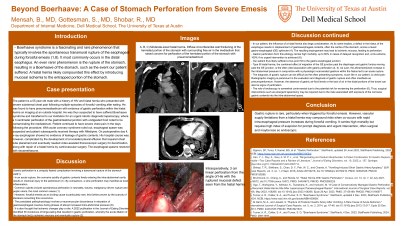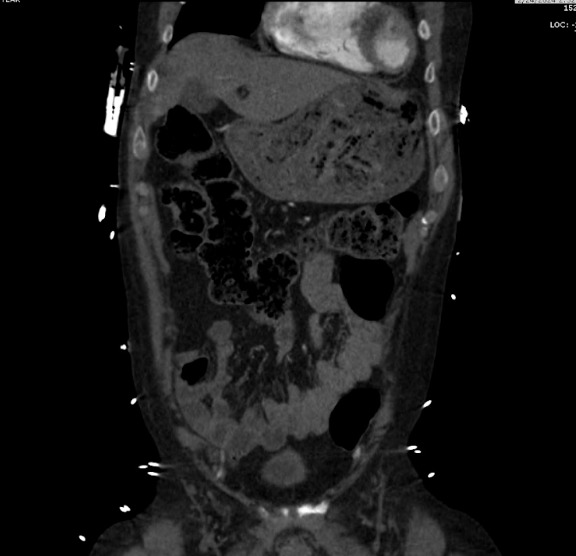Monday Poster Session
Category: Stomach
P3356 - Beyond Boerhaave: A Case of Stomach Perforation from Severe Emesis
Monday, October 28, 2024
10:30 AM - 4:00 PM ET
Location: Exhibit Hall E

Has Audio
- BM
Barbara Mensah, MD
University of Texas at Austin Dell Medical School
Austin, TX
Presenting Author(s)
Barbara Mensah, MD, Rima Shobar, MD, Sara Gottesman, MD
University of Texas at Austin Dell Medical School, Austin, TX
Introduction: Forceful emesis has some known associated gastroesophageal complications. These range from mild presentations, such as Mallory Weiss tears, to more severe, such as Boerhaave syndrome in which esophageal involvement is more expected. However, stomach rupture is a rare and unusual presentation. In this paper, we discuss the unexpected gastric rupture of a patient following forceful emesis. We also explored the likelihood of a hiatal hernia being a risk factor.
Case Description/Methods: A 55 year old male with a history of HIV and a hiatal hernia who presented with severe substernal chest pain following multiple episodes of forceful vomiting. CT scan showed pneudomediastinum with evidence of perforation of stomach within a hiatal hernia and the chest, consistent with Boerhaave Syndrome. Patient underwent urgent robotic diagnostic laparoscopy which showed a gastric perforation within a hiatal hernia extending to the gastroesophageal junction. The defect was fixed and hiatal hernia was repaired. Post surgery the patient recovered without complication.
Discussion: Boerhaave syndrome typically involves the spontaneous transmural rupture of the esophageal wall during forceful emesis (1,8). The intraesophageal pressures generated against the fixed walls of the cricopharyngeus muscles drives baro-trauma that manifests as wall perforation (1). It most commonly occurs in the distal esophagus and can carry a mortality up to 40% (5,9). An even more rare phenomenon is the rupture of the stomach following forceful vomiting, resulting in a Boerhaave of the stomach, such as the event our patient suffered.
Commonly cited culprits for gastric perforation are events such as spontaneous perforation often seen in neonates, trauma, iatrogenic instructmental injury (such as during endoscopy) and peptic ulcers. However, the incidence of gastric rupture from forceful emesis is so rare that not much literature has been published. In our patient, we believe the increased intraabdominal pressure during forceful vomiting in conjunction with incarceration of a hiatal hernia triggered this event.

Disclosures:
Barbara Mensah, MD, Rima Shobar, MD, Sara Gottesman, MD. P3356 - Beyond Boerhaave: A Case of Stomach Perforation from Severe Emesis, ACG 2024 Annual Scientific Meeting Abstracts. Philadelphia, PA: American College of Gastroenterology.
University of Texas at Austin Dell Medical School, Austin, TX
Introduction: Forceful emesis has some known associated gastroesophageal complications. These range from mild presentations, such as Mallory Weiss tears, to more severe, such as Boerhaave syndrome in which esophageal involvement is more expected. However, stomach rupture is a rare and unusual presentation. In this paper, we discuss the unexpected gastric rupture of a patient following forceful emesis. We also explored the likelihood of a hiatal hernia being a risk factor.
Case Description/Methods: A 55 year old male with a history of HIV and a hiatal hernia who presented with severe substernal chest pain following multiple episodes of forceful vomiting. CT scan showed pneudomediastinum with evidence of perforation of stomach within a hiatal hernia and the chest, consistent with Boerhaave Syndrome. Patient underwent urgent robotic diagnostic laparoscopy which showed a gastric perforation within a hiatal hernia extending to the gastroesophageal junction. The defect was fixed and hiatal hernia was repaired. Post surgery the patient recovered without complication.
Discussion: Boerhaave syndrome typically involves the spontaneous transmural rupture of the esophageal wall during forceful emesis (1,8). The intraesophageal pressures generated against the fixed walls of the cricopharyngeus muscles drives baro-trauma that manifests as wall perforation (1). It most commonly occurs in the distal esophagus and can carry a mortality up to 40% (5,9). An even more rare phenomenon is the rupture of the stomach following forceful vomiting, resulting in a Boerhaave of the stomach, such as the event our patient suffered.
Commonly cited culprits for gastric perforation are events such as spontaneous perforation often seen in neonates, trauma, iatrogenic instructmental injury (such as during endoscopy) and peptic ulcers. However, the incidence of gastric rupture from forceful emesis is so rare that not much literature has been published. In our patient, we believe the increased intraabdominal pressure during forceful vomiting in conjunction with incarceration of a hiatal hernia triggered this event.

Figure: Gastric rupture within a hiatal hernia
Disclosures:
Barbara Mensah indicated no relevant financial relationships.
Rima Shobar indicated no relevant financial relationships.
Sara Gottesman indicated no relevant financial relationships.
Barbara Mensah, MD, Rima Shobar, MD, Sara Gottesman, MD. P3356 - Beyond Boerhaave: A Case of Stomach Perforation from Severe Emesis, ACG 2024 Annual Scientific Meeting Abstracts. Philadelphia, PA: American College of Gastroenterology.
